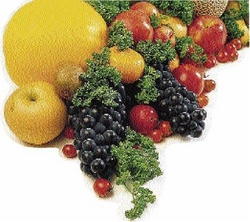Filling up on fibre
Published: Tuesday | September 8, 2009


Nearly everyone has heard about the need for fibre in the diet. But few people really understand its vital importance.
Fibre (roughage) is an almost indigestible substance that is found only in plants. No animal products contain fibre - not even bones or egg shells. It is a special type of carbohydrate that passes through the human digestive system virtually unchanged, without being broken down. There are two main types of fibre:
Insoluble fibre is mainly made up of the cell walls of plants, and cannot be dissolved in water. It benefits digestive functions and has a good laxative action. Cellulose is a common example of an insoluble fibre;
Soluble fibre does dissolve in water into a jellylike substance and has many beneficial effects on body chemistry.
A good diet should contain approximately 25 to 30 grams of a mixture of both soluble and insoluble fiber per day. The modern western diet on average contains less that half of that. Americans consume only about 10 per cent of the fibre that they did 100 years ago.
Soluble fibre is found in all plant foods, including legumes, peas, soybeans, and other beans, grains like oats, rye, and barley, fruits and fruit juices, vegetables such as broccoli and carrots, root vegetables such as potatoes, sweet potatoes, and onions and psyllium seed husk (a mucilage soluble fibre).
Insoluble fibre is found in whole grain foods, wheat and corn bran, nuts and seeds, potato skins, flax seed, vegetables such as green beans, cauliflower, zucchini, celery, the skins of some fruits, including tomatoes.
Legumes, which includes several types of beans, lentils and peas with 15-19 grams of fiber per cup serving, are probably the foods with the highest fibre content.
FIBRE FOR HEALTH DIGESTION
Fibre has a great influence on the digestion process because it requires more chewing.
It slows down the eating process and helps increase the feeling of fullness which improves digestion and helps prevent overeating.
Fibre keeps stool soft by absorbing water. It keeps the contents of the intestines moving by increasing peristalsis. The insoluble fibre in the stool sweeps the walls of the intestines as it moves through brushing away old cells in the process.
Soluble fibre acts as a prebiotic. Bacteria in the colon feed on it breaking it down to form short-chain fatty acids. These acids increase the absorption of calcium, magnesium, and iron into the cells lining the colon wall and enhance their health. The fatty acids also provide fuel for the rest of the body, especially the liver. Fibre in our food promotes an increase in the number and health of the good intestinal bacteria lactobacillus and bifidobacterium, protecting the digestive tract from infections, inflammation and cancer.
FIBRE for DISEASE PREVENTION
A high-fibre consumption is associated with a reduced risk of type two diabetes, heart disease, stroke, hypertension, obesity and several cancers particularly colon, breast and prostate cancers, colitis, diverticulitis and haemorrhoids
FIBRE for CHOLESTEROL and BLOOD SUGAR
Fibre slows digestion and absorption so that glucose (sugar) from carbohydrate foods enters the bloodstream more slowly, and keeps blood sugar more in balance. Soluble fibre also traps cholesterol in the food and reduces its absorption into the blood stream.
FIBRE for OBESITY
Obesity is the most common form of malnutrition and a major factor in the cause of heart disease, cancers and stroke. Foods that help conquer obesity are very desirable.
HELPFUL HINTS ABOUT FIBRE
Slowly increase the amount you consume until you reach your recommended amount. Increasing too quickly can lead to gas, bloating and diarrhoea. Pay attention to how your bowel movements are responding to your fibre intake.
DRINK MORE WATER
If you do not have enough fluids (preferably water) with your high-fibre diet, you may end with constipation. Aim for eight glasses per day or half an ounce per pound body weight.
TAKE FIBRE SUPPLEMENTS
While increasing your intake of high fibre foods consider taking a supplement. I suggest that you choose one that is a combination of soluble and insoluble fibre. It should also contain the healthy bacteria like lactobacillus. This prebiotic and probiotic combination provides synergistic benefits.
BE CREATIVE
Have veggies with your meals whenever possible. Use fruit with or between meals. Go for the fruit with the skin and/or seeds for the fibre.
You may email Dr Vendryes at vendryes@mac.com or listen to An Ounce of Prevention on POWER 106FM on Fridays at 8 p.m. The programme streams live on the Internet.







